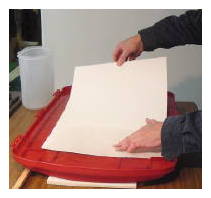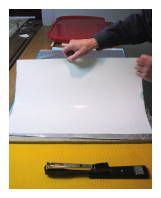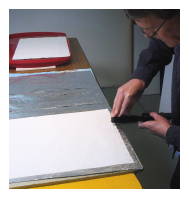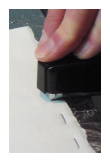|
DEMOS & TIPS
|
Stretching PaperPaper Weights - Buckling - Stretching Paper
By David Cuin
Papers for watercolor are not designated by thickness, which would be difficult to measure on a textured surface, but more usually by weight. The weight of watercolor paper is based on a ream (500 sheets) of "full" sheets. A full watercolor sheet measures 30" x 22". The weights in which we are most interested are 140 lb and 300 lb. The 140 lb paper feels like thick paper or thin card while 300 lb paper is much stiffer, like cardboard. Three textures are available in these weights - hot-pressed (smooth), cold-pressed, sometimes called "Not" meaning not hot-pressed (lightly textured), and rough. A 90 lb weight paper is also available but not recommended due to its tendency to buckle badly when wet. One manufacturer (Saunders Waterford) produces a 200 lb weight paper that is only available in cold-pressed and hot-pressed at this time. Which weight of paper you choose to paint on depends on the size of painting you want to make, the technique you want to use and your income. The big determining factor is buckling, or "cockling" as it is sometimes called. When paper gets wet it expands and buckles, the bigger the piece the more severe the buckling. You can offset this by using thicker, i.e., heavier, paper. If you can afford 300 lb paper, you can paint up to half sheet size and, depending on how much water is in your painting technique, perhaps even full sheet without worrying too much about buckling. But, 300 lb paper is expensive; you may need to use 140 lb paper, which is what most artists do. If you secure the edges of the 140 lb paper well, it can be used up to quarter sheet size (15" x 11") quite successfully. Larger works, or those using techniques that employ a lot of water, require 140 lb paper to be pre-stretched to reduce its tendency to buckle. When dry paper fibers become moist they expand. Typically in a painting, a wetted area may be adjacent to or surrounded by dry paper. The expanded dimension of the moistened fibers has nowhere to go in the plane of the paper, and it can only be accommodated by rippling up and down out of the flat plane. You can easily test this for yourself by taking some ordinary typing paper and wetting a patch; the ripples rapidly appear. You can minimize the tendency to buckle by pre-stretching watercolor paper. There are several ways to stretch watercolor paper but in principle the paper is wetted, securely fastened down at the edges to a strong rigid board, then allowed to dry. The way that has worked best for me is to use a sheet of plywood or Homosote (see below) not less than 1/2" thick and at least an inch larger in size than the paper to be stretched. Cover the plywood with a waterproof membrane to stop soluble compounds in the board from being transferred to the wet paper. I use aluminum foil but plastic wrap or a coat of house paint would also work. Wet the paper thoroughly perhaps in the bathtub or, as in this case, the detached lid of a large plastic storage container. Soak until it is limp, taking care not to damage the surface (handle it by the edges) or contaminate the paper with soap or other compounds. Make sure there are no air bubbles trapped under it while it soaks because these will prevent the paper from becoming evenly saturated. Soak it for at least half an hour. Lift it by the edges and allow to drain. Carefully lay the wet paper onto the board starting at one edge so that air pockets are driven out. It's a good idea to lay aluminum foil or Saran wrap over the board so that soluble salts do not leach out into the wet paper and perhaps stain it. Be sure to avoid buckling the wet paper (like this) or it may produce dark marks when the watercolor is applied. Staple the edges with a handyman stapler (office staplers are not strong enough for plywood) about 3/8" in from the edge of the paper and at about 1-1 1/2" intervals. Paper is quite strong when it tries to shrink on drying so a board less than 1/2" thick will tend to bow and staples placed further apart than 1 1/2" will allow the paper to tear. There is a dense fiberboard called Homosote sometimes available from DIY stores or lumberyards that can also be used and this will take office staples. This is what I am using in the illustrations. When the office stapler is opened up be sure the end of the base does not mark the tender surface of the wet paper when you staple. Nowadays, there are also foam-cored boards (Gatorboard) that are reputed to suffice. Many books, especially the older ones, advise you to use gummed paper tape to hold down the paper's edges but I have never been able to make that method work for me.Allow the paper to dry for 24 hours before removing it from the board. © 2024 by David Cuin, all rights reserved.
|






